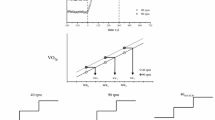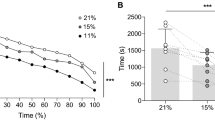Abstract
Prior heavy-intensity exercise facilitates the pulmonary oxygen uptake (V̇O2) response during subsequent exercise, such that its kinetics returns towards first-order. To better understand this “priming” phenomenon, we investigated the effect of priming exercise, over a range of intensities, on the V̇O2 response to heavy-intensity cycle ergometry at a work rate of Δ50% [halfway between lactate threshold (LT) and V̇O2max]. Eight subjects performed two consecutive 6-min bouts separated by 6 min at 20 W. The first bout was each of: no warm-up control (CON), sub-lactate threshold (LT) at 80% of LT, and three supra-LT conditions (Δ20%, Δ40%, and Δ60%). The V̇O2 response during the subsequent bout was evaluated using the “effective” time constant (τ′), and the V̇O2 difference between minutes 3 and 6 (ΔV̇O2(6–3)). The goodness-of-fit, indicative of “first-order” kinetics, was determined by the residual profile, and the mean square of errors (MSEr). The heart rate and blood lactate concentration ([La]r) just prior to the second bout were also measured. Compared with CON, τ′ and ΔV̇O2(6–3) were significantly reduced following all supra-LT priming bouts, while the goodness-of-fit was significantly improved following Δ40% exercise. ΔV̇O2(6–3) and [La]r were negatively correlated (P<0.05), unlike HR. In conclusion, prior exercise just above, but not below, LT facilitated the V̇O2 response in a threshold-like manner. Supra-LT priming exercise influenced the V̇O2 response allowing it to return to within as little as 12% from first-order (compared to ~50% in CON). The associated increases in circulating lactate and/or related factors seem to be centrally involved in this phenomenon.





Similar content being viewed by others
References
Bangsbo J (2000) Muscle oxygen uptake in humans at onset of and during intense exercise. Acta Physiol Scand 168:457–464
Bangsbo J, Gibala MJ, Krustrup P, Gonzalez-Alonso J, Saltin B (2002) Enhanced pyruvate dehydrogenase activity does not affect muscle O2 uptake at onset of intense exercise in humans. Am J Physiol 282:R273–R280
Barstow TJ, Casaburi R, Wasserman K (1993) O2 uptake kinetics and the O2 deficit as related to exercise intensity and blood lactate. J Appl Physiol 75:755–762
Bearden SE, Moffatt RJ (2001) V̇O2 and heart rate kinetics in cycling: transitions from an elevated baseline. J Appl Physiol 90:2081–2087
Beaver WL, Wasserman K, Whipp BJ (1986) A new method for detecting anaerobic threshold by gas exchange. J Appl Physiol 60:2020–2027
Bohnert B, Ward SA, Whipp BJ (1998) Effects of prior arm exercise on pulmonary gas exchange kinetics during high-intensity leg exercise in humans. Exp Physiol 83:557–570
Burnley M, Jones AM, Carter H, Doust JH (2000) Effects of prior heavy exercise on phase II pulmonary oxygen uptake kinetics during heavy exercise. J Appl Physiol 89:1387–1396
Burnley M, Doust JH, Carter H, Jones AM (2001) Effects of prior exercise and recovery duration on oxygen uptake kinetics during heavy exercise in humans. Exp Physiol 86:417–425
Burnley M, Doust JH, Ball D, Jones AM (2002) Effects of prior heavy exercise on V̇O2 kinetics during heavy exercise are related to changes in muscle activity. J Appl Physiol 93:167–174
Capelli C, Cautero M, di Prampero PE (2001) New perspectives in breath-by-breath determination of alveolar gas exchange. Pflugers Arch 441:566–577
Casaburi R, Storer TW, Ben-Dov I, Wasserman K (1987) Effect of endurance training on possible determinants of V̇O2 during heavy exercise. J Appl Physiol 62:199–207
Casaburi R, Barstow TJ, Robinson T, Wasserman K (1989) Influence of work rate on ventilatory and gas exchange kinetics. J Appl Physiol 67:547–555
Cautero M, Beltrami A, di Prampero PE, Capelli C (2002) Breath-by-breath alveolar oxygen transfer at the onset of step exercise in humans: methodological implications. Eur J Appl Physiol 88:203–213
Demarle AP, Slawinski JJ, Laffite LP, Bocquet VG, Koralsztein JP, Billat VL (2001) Decrease of O2 deficit is a potential factor in increased time to exhaustion after specific endurance training. J Appl Physiol 90:947–953
di Prampero PE, Davies CTM, Cerretelli P, Margaria R (1970) An analysis of O2 debt contracted in submaximal exercise. J Appl Physiol 29:547–551
di Prampero PE, Mahler PB, Giezendanner D, Cerretelli P (1989) Effects of priming exercise on V̇O2 kinetics and O2 deficit at the onset of stepping and cycling. J Appl Physiol 66:2023–2031
Endo M, Tauchi S, Hayashi N, Koga S, Rossiter HB, Fukuba Y (2003) Facial cooling-induced bradycardia does not slow pulmonary V̇O2 kinetics at the onset of high-intensity exercise. J Appl Physiol 95:1623–1631
Fukuba Y, Whipp BJ (1999) The “fatigue threshold”: its physiological significance for assigning the transition from heavy to severe exercise. In: Sato M, Tokura H, Watanuki S (eds) Recent advance in physiological anthropology. Kyushu University Press, Fukuoka, pp 341–346
Fukuba Y, Tanoue A, Tanaka M, Miura A (1998) Effect of prior “acid-up” exercise on pulmonary V̇O2 kinetics during heavy exercise. In: Nose H, Nadel ER, Morimoto T (eds) The 1997 Nagano Symposium on Sports Sciences. Cooper, Carmel, Ind., pp 132–138
Fukuba Y, Hayashi N, Koga S, Yoshida T (2002) V̇O2 kinetics in heavy exercise is not altered by prior exercise with a different muscle group. J Appl Physiol 92:2467–2474
Gaesser GA, Poole DC (1996) The slow component of oxygen uptake kinetics in humans. Exerc Sport Sci Rev 24:35–71
Gerbino A, Ward SA, Whipp BJ (1996) Effects of prior exercise on pulmonary gas-exchange kinetics during high-intensity exercise in humans. J Appl Physiol 80: 99–107
Grassi B, Hogan MC, Greenhaff PL, Hamann JJ, Kelley KM, Aschenbach WG, Constantin-Teodosiu D, Gladden LB (2002) Oxygen uptake on-kinetics in dog gastrocnemius in situ following activation of pyruvate dehydrogenase by dichloroacetate. J Physiol (Lond) 538:195–207
Koppo K, Bouckaert J (2000) In human the oxygen uptake slow component is reduced by prior exercise of high as well as low intensity. Eur J Appl Physiol 83:559–565
Koppo K, Bouckaert J (2001) The effect of prior high-intensity cycling exercise on the V̇O2 kinetics during high-intensity cycling exercise is situated at the additional slow component. Int J Sports Med 22:21–26
Koppo K, Bouckaert J (2002) The decrease in the V̇O2 slow component induced by prior exercise does not affect the time to exhaustion. Int J Sports Med 23:262–267
Lamarra N, Whipp BJ, Ward SA, Wasserman K (1987) Effect of interbreath fluctuations on characterizing exercise gas exchange kinetics. J Appl Physiol 62:2003–2012
MacDonald M, Pedersen PK, Hughson RL (1997) Acceleration of V̇O2 kinetics in heavy submaximal exercise by hyperoxia and prior high-intensity exercise. J Appl Physiol 83:1318–1325
MacDonald MJ, Naylor HL, Tschakovsky ME, Hughson RL (2001) Peripheral circulatory factors limit rate of increase in muscle O2 uptake at onset of heavy exercise. J Appl Physiol 90:83–89
Miura A, Shiragiku T, Hirotoshi Y, Barstow TJ, Whipp BJ, Fukuba Y (2000) The effect of prior heavy exercise on the parameters of the power-duration curve for cycle ergometry [abstract]. Physiologist 43:324
Miura A, Endo M, Sato H, Sato H, Barstow TJ, Fukuba Y (2002) Relationship between the curvature constant parameter of the power-duration curve and muscle cross-sectional area of the thigh for cycle ergometry in humans. Eur J Appl Physiol 87:238–244
Motulsky H, Ransnas L (1987) Fitting curves to data using nonlinear regression: a practical and nonmathematical review. FASEB J 1:365–374
Poole DC, Ward SA, Whipp BJ (1990) The effects of training on the metabolic and respiratory profile of high-intensity cycle ergometer exercise. Eur J Appl Physiol 59:421–429
Poole DC, Schaffartzik W, Knight DR, Derion T, Kennedy B, Guy HJ, Prediletto R, Wagner PD (1991) Contribution of excising legs to the slow component of oxygen uptake kinetics in humans. J Appl Physiol 71:1245–1260
Poole DC, Gladden LB, Kurdak S, Hogan MC (1994) l-(+)-Lactate infusion into working dog gastrocnemius: no evidence lactate per se mediates V̇O2 slow component. J Appl Physiol 76:787–792
Rossiter HB, Ward SA, Kowalchuk JM, Howe FA, Griffiths JR, Whipp BJ (2001) Effects of prior exercise on oxygen uptake and phosphocreatine kinetics during high-intensity knee-extension exercise in humans. J Physiol (Lond) 537:291–303
Rossiter HB, Ward SA, Howe FA, Kowalchuk JM, Griffiths JR, Whipp BJ (2002) Dynamics of the intramuscular 31P MRS Pi peak-splitting and the slow component of PCr and O2 uptake during exercise. J Appl Physiol 93:2059–2069
Rossiter HB, Ward SA, Howe, FA, Wood, DM, Kowalchuk JM, Griffiths JR, Whipp BJ (2003) Effects of dichloroacetate on V̇O2 and intramuscular 31P metabolite kinetics during high-intensity exercise in humans. J Appl Physiol 95:1105–1115
Roston WL, Whipp BJ, Davis JA, Cunningham DA, Effros RM, Wasserman K (1987) Oxygen uptake kinetics and lactate concentration during exercise in humans. Am Rev Respir Dis 135:1080–1084
Saunders MJ, Evans EM, Arngrimsson SA, Allison JD, Warren GL, Cureton KJ (2000) Muscle activation and the slow component rise in oxygen uptake during cycling. Med Sci Sports Exerc 32:2040–2045
Scheuermann BW, Hoelting BD, Noble ML, Barstow TJ (2001) The slow component of V̇O2 uptake is not accompanied by changes in muscle EMG during repeated bouts of heavy exercise in humans. J Physiol (Lond) 531:245–256
Scheuermann BW, Bell C, Paterson DH, Barstow TJ, Kowalchuk JM (2002) Oxygen uptake kinetics for moderate exercise are speeded in older humans by prior heavy exercise. J Appl Physiol 92:609–616
Starritt EC, Angus D, Hargreaves M (1999) Effect of short-term training on mitochondrial ATP production rate in human skeletal muscle. J Appl Physiol 86:450–454
Timmons JA, Gustafsson T, Sundberg CJ, Jansson E, Greenhaff PL (1998) Muscle acetyl group availability is a major determinant of oxygen deficit in humans during submaximal exercise. Am J Physiol 274:E377–E380
Tschakovsky ME, Hughson RL (1999) Interaction of factors determining oxygen uptake at the onset of exercise. J Appl Physiol 86:1101–1113
Walsh ML, Takahashi A, Endo M, Miura A, Fukuba Y (2002) Effects of ischaemia on subsequent exercise-induced oxygen uptake kinetics in healthy adult humans. Exp Physiol 87:227–235
Whipp BJ (1994a) The slow component of O2 uptake kinetics during heavy exercise. Med Sci Sports Exerc 26:1319–1326
Whipp BJ (1994b) The bioenergetic and gas exchange basis of exercise testing. Clin Chest Med. 15:173–192
Whipp BJ (1996) Physiological basis of athletic performance. Med Sport 49:231–245
Whipp BJ, Wasserman K (1972) Oxygen uptake kinetics for various intensities of constant-load work. J Appl Physiol 33:351–356
Whipp BJ, Ward SA, Lamarra N, Davis JA, Wasserman K (1982) Parameters of ventilatory and gas exchange dynamics during exercise. J Appl Physiol 52:1506–1513
Acknowledgements
This study was supported in part by Grant-in-Aid for Scientific Research from The Ministry of Education, Science, Sports and Culture in Japan to YF (no. 12680048) and Uehara Memorial Life Science Foundation to Y.F. H.B.R. is an International Prize Traveling Fellow of The Wellcome Trust UK (no. 064898).
Author information
Authors and Affiliations
Corresponding author
Rights and permissions
About this article
Cite this article
Endo, M., Usui, S., Fukuoka, Y. et al. Effects of priming exercise intensity on the dynamic linearity of the pulmonary V̇O2 response during heavy exercise. Eur J Appl Physiol 91, 545–554 (2004). https://doi.org/10.1007/s00421-003-1005-1
Accepted:
Published:
Issue Date:
DOI: https://doi.org/10.1007/s00421-003-1005-1




